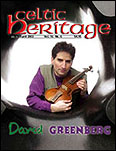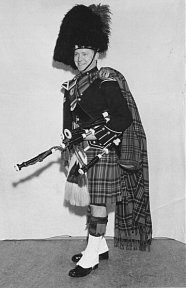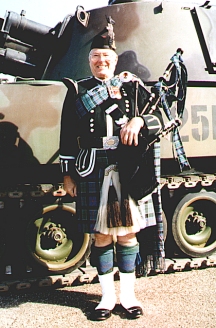 |
Celtic Heritage Magazine March/April 2003 www.celticheritage.ns.ca |
 |
Celtic Heritage Magazine March/April 2003 www.celticheritage.ns.ca |

As a little boy, Don Roy would sit on the floor and watch and listen while the Pictou Highlanders Militia Pipe Band practiced in his home. Often he fell asleep to the sounds of the pipes. Don's father, Wallace Roy, Pipe Major of the band, often brought members to the house for practice sessions.
It wasn't until 1943 that the then 13-year-old boy first visited Halifax. It was a city at war and the military facilities, with army navy and air force personnel and materiel everywhere, may well have affected the young man. Later in life he chose a military career for himself.In 1944, Wallace Roy, who had enlisted at the start of the war, came home on a medical discharge and took his two young boys, Al and Don to watch the Pictou Highlanders perform a Ceremonial Retreat in Carmichael Park in New Glasgow. It was a very moving performance and, when Don looked up and saw tears in his father's eyes, he knew he wanted to become a piper. Wallace, it seems, had been waiting for the boys to ask, because as soon as they did, he sent for chanters and started giving them lessons.
A year later, Don joined the Pictou Highlanders Reserve Army Pipe Band under Pipe Major Fraser Holmes. His first parade went right up the main street of New Glasgow, with Don marching beside Pipe Major Holmes. When word was received of the German surrender, the band paraded through the streets of Stellarton, New Glasgow, Wesville, and Trenton. They were playing at Greenhill Look-off when the news of V.J.Day (Victory in Japan) was received.
In July 1945, the band went to summer camp at Beach Grove, near Charlottetown, Prince Edward Island. Don was invited to play with Don Messer and His Islanders on their radio show, and a few days later the band played live on radio with Don playing yet another solo.
That summer, Don attended his first Antigonish Games, placing third in the Amateur March. In 1946, he won both the March and the Strathspey and Reel, and in 1948, he again won the March but placed second in the Strathspey and Reel.
When Don was entering Grade 12, he skipped the first day of school to play in the Lobster Carnival Parade in Pictou. When he showed up the next day, he was hassled by his teachers and quit, suddenly ending his secondary education.
In July 1947, Don was helping to lay rails at West River. Finishing work early one day, a couple of the guys decided to head back on a flat bed car instead of waiting for the regular transport. Arriving at the boarding cars, the driver slowed down to allow them to jump off, but Don slipped. His head hit the rail, and his arm was pinned under the flange of the wheel. The top of his forearm was sliced open leaving bone, tendons and muscles hanging out. At least two inches of the artery was exposed, but luckily not severed. Don remembered seeing his injured arm and thinking, "Oh my God! I'll never be able to play the pipes again!"
He walked half a mile to the train station where a tourniquet was applied and from there he was driven to the hospital. The arm was saved, despite a severe infection. The skin grafts were not completely successful and when he was released from the hospital, he couldn't open his hand and was limping from complications where they had taken the grafting from his leg. He started exercises with a rubber ball and before long was once again playing his pipes.
That November, Don went to Kitchener, Ontario, looking for work and joined the Royal Scots Fusiliers Militia Band. But it was inactive at the time and he didn't feel comfortable with them. Homesick, he returned to Nova Scotia in May 1948 and rejoined the Pictou Highlanders Pipe Band.
Don joined the regular army in 1951 and soon found himself at Camp Valcartier, near Quebec City. Other companies arrived from across Canada to form the 1st Canadian Highland Battalion. Don soon joined the battalion's pipeband, which wore a mixture of five different tartans and different sporrans, etc. That didn't help the unit bond together. Pipe Major Keith Lee of the 48th Highlanders had the formidable job of trying to make the pipe band work. Don, however, felt like an outsider, and was very glad when two new recruits showed up, Jack Fleming and Harold Hayden, both friends from Nova Scotia.
On December 2nd, 1951, the 1st Canadian Highland Battalion of the 27th Brigade Group shipped out aboard the S.S. Canberra, the first N.A.T.O. troops to be posted to Germany. Every day of the voyage, the pipes and drums performed on the deck of the ship.
Two months later King George VI died and the Battalion had an impromptu parade on the Square in the afternoon. Don was not informed and woke to the sound of the pipes. He was charged for being absent from place of duty, but his friend Jack Fleming, who had been Duty N.C.O., came to his rescue and testified that he had not warned Don of the parade. Later the same year, he learned that the pipe band would take part in the Edinburgh Tattoo that August. Individual regimental affiliations were abandoned and the band was issued with the Cameron tartan in time for the performance. The 1st Canadian Highland Battalion Pipes and Drums were housed at the Castlehill School, in front of Edinburgh Castle, while all the other bands and performers had to be bussed to barracks in the suburbs.
The Scots loved the Canadians and Don and the others, always in uniform, were warmly greeted wherever they went. They spent a fair amount of time at the Palais, a dance hall, and it was there that he met his future wife, Beth, a young woman from Dunbar, Scotland. The 1st Canadians didn't get to the coronation of Queen Elizabeth, but the pipe band did have a role to play in its success. Three days later after the coronation, they took part in the Royal Tournament that was held nightly for three weeks at Earl's Court. Don volunteered for "carpet duty", which meant that he stood to one side of the red carpet as the members of the Royal Family and other notables such as Clement Atlee and Sir Winston Churchill were taken from the royal box to their waiting vehicles.
In March 1953, Don proposed to Beth and the wedding was set for September. He spent part of the waiting time preparing for and performing in the White City Tattoo in London with, among others, the Massed Pipes and Drums of the Brigade of Gurkas, from Nepal. At the end of the run, the band returned to Germany where they began rehearsals for the upcoming Edinburgh Tattoo.
Back in Edinburgh, the band stayed at Redford Barracks where they were hosted by the Queen's Own Cameron Highlanders. Don spent much of his free time visiting with Beth, and when the show was over, he was given two weeks leave and headed back to Dunbar. The wedding was three days later.
On November 30, Don, soon followed by Beth returned to Canada. He received his release papers on February 11th, 1954, but was unhappy as a civilian and soon re-enlisted. He was posted to Camp Aldershot in Kentville, Nova Scotia, with the Pipes and Drums of the 2nd Battalion Black Watch (Royal Highland Regiment) of Canada under the direction of the Pipe Major Duncan Rankine, a crusty old Scot who had been with the Royal Scots during the war. Don's friend, Bill Magennis was now Pipe Major of the 1st Battalion and both bands played around Nova Scotia and attended the Antigonish Highland Games. At the end of the run, the tattoo cast was moved to Copenhagan where they performed the complete show again. One of the highlights of his trip to Denmark was a dinner with Prince Viggio, the uncle of King Frederick.
In 1956, the band travelled to New York City to play for the St. Andrew's Society. They also travelled to Toronto to participate in the Grandstand Show at the Canadian National Exhibition and, the following year, to Bermuda to participate in yet another British Military Searchlight Tattoo.
The following summer, the 1st and 2nd Battalion Pipes and Drums and the Military Band travelled to Washington, D.C. where they performed on the grounds of the British Embassy as Queen Elizabeth II hosted a garden party for President Eisenhower. They paraded down Constitution Avenue, played in concert at the Pentagon, and gave a full dress retreat ceremony at Fort Myers, Virginia.
In May 1958, the Battalion moved from Camp Aldershot to the new CAmp Gagetown in New Brunswick. The band toured many of the smaller towns in the Maritimes and were very well received everywhere they went. The best reception was in Cape Breton -- no surprise to anyone.
The following year, Pipe Major Rankine retired and Bill Gilmour took over the band. His piping skills were of a very high standard and the Pipes and Drums flourished under his leadership. In August 1959, the band played for a mini tattoo on the nOrth Commons of Halifax. Returning to Camp Gagetown, the bus, nicknamed the Flyer, stopped at the Nova Scotia-New Brunswick border long enough for Don to greet his father. It was their last meeting. Pipe Major Wallace Roy was killed in a car accident on August 30th, just three days after his 56th birthday.
That fall, the band performed in Montreal and at a CAnadian Football League game in Philadelphia. IN 1961, they played another mini tattoo in Halifax where Queen Elizabeth II took the salute. The next morning, they travelled to Toronto and then on to Vancouver to participate in the Pacific National Exhibition. For the next three weeks, the band rehearsed for and performed in the PNE show, played in a parade through the streets of Vancouver, and entered a band competition. The day after they returned to Camp Gagetown, they played as a British Battalion boarded an aircraft to England after their course of training in Camp Gagetown.
In February 1962, the band travelled back to Germany. As the band was an integral part of the Infantry Battalion, the pipers and drummers were soldiers first and bandsmen second, and training was soon underway in earnest. The band performed frequently, however, across Germany, in the Netherlands, and in Belgium. IN the summer, they took part in the Musicfest in Mons, Belgium. IN August, they shipped out for Scotland to take part in the Edinburgh Tattoo. Also taking part in the TAttoo of 1962 was the Sikh's Massed Pipes and Drums of the Indian Army. Don made friends with one of the Sikh pipers who read his palm and told him he would live to old age and never be wanting financially.
In 1963, the band went to a small NATO Taptoe (Tattoo) in Coevorden, a Dutch town right on the German border, and to another in Arnham. The Tattoo was of high quality, with the combined bands playing "The Grand March from Tannhauser" by Wagner as a finale. The band also performed in a huge Charity Show held in a famous opera house in Brussels to raise funds for the Belgique Forces.
In 1964, Don left the pipes and drums and transferred to the Dental Corps. He became very interested in his new career and lost some of his interest in playing pipes. In July 1965, he returned to Camp Gagetown, but had little to do with piping until 1968. At that time the 1st Battalion was posted in Cyprus. Pipe Major Gilmour of the 2nd Battalion needed two more pipers for a British Military Tattoo in Jamaica and arranged for Don to come along. In addition to performing in the Tattoo, they played at a local hospital and appeared on television. When the band returned to Camp Gagetown, Don returned to the Dental Corps.
In 1971, he was posted to CFB Shilo in Manitoba where he found that he was the only piper on the base. In 1972, he joined the local Brandon band, the 26th Field REgiment Royal Canadian Artillery, which was a good parade band and enjoyed it immensely. He was also asked to play at all the Officer's and Senior NCO mess functions.
In 1974, Don played with the Massed Pipes and Drums of Winnipeg at the Rose Bowl Parade in Pasadena, California. The band also played at City Hall, aboard the Queen Mary, and at Disneyland. Later in 1974, the 26th Field Regiment acquired a new pipe major, Alex Cupples, who took the band into competition at the Grade 3 level, winning most of their competitions during the last half of the 1970s. Cupples and Don played together at many functions at Camp Shilo. At the same time, Pipe Major Hugh MacPherson was posted to CFB Portage La Prairie, and set up a pipe band there. Don frequently went along to help, especially when the young and inexperienced band was asked to play at important parades.
Don retired from the Canadian Forces in 1980. IN the mid 1980s, he left the 26th Field Pipe Band and joined the CFB Portage Pipes and Drums under Pipe Major Ernie Fox, and soon realized that air travel was a perk in belonging to an air force band. The most memorable trip was to Plante City, Florida, where they played for a Strawberry Festival, at the EPCOT Centre, and at Disneyworld.
In 1991, Don played once more at the Nova Scotia International Tattoo. It was an honour for him to play with the Fraser Holmes Memorial Pipe Band from New Glasgow, and to meet his cousin's wife, Drum Major Noreen Roy. Of all the tattoos he'd experienced, Don felt that the Nova Scotia Tattoo was the most spectacular. Later, when the military pulled out of Portage La Prairie, the band lost its uniforms and its drummers, but the pipers pulled together and within a year another band was off the ground, and completely unfitted.
In January, 1993, Don joined the Pipes and Drums of the 1st Regiment Royal Canadian Horse Artillery (1RCHA) and continues to play at all of their military and civilian functions from Base Parades to St. Patrick's Day Parades every year at Deadwood, South Dakota. He teaches a number of young people to play the pipes and also plays at retirement homes, schools, funerals, weddings, and pipes in head table guests at banquets. After fifty-eight years, he expects to continue playing the music he loves for many more to come.
Scott Williams
Celtic Heritage Magazine
March/April 2003
www.celticheritage.ns.ca

![]()
![]()
Don Roy e-Mail
donroy204@gmail.com
WebMaster:
Bill Hillman
BILL
and SUE-ON HILLMAN ECLECTIC STUDIO